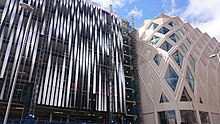The Moorside was a two-part British television drama broadcast on BBC One earlier this month. The drama is centred on the Yorkshire community that led the search for missing schoolgirl Shannon Matthews in 2008 after her 'disappearance,' as well as the revelation of her mother Karen's involvement in the crime after Shannon was 'found.' The title of the drama references the Moorside housing estate in Dewsbury, where the Matthews family lived.
Having watched the BBC's 'pure drama' feature, I have been following the programmes reception and critical perception. While The Moorside is noted as being a triumph for the BBC and has been praised for its 'sensitive portrayal of events' as well as the acting of stars Sheridan Smith and Gemma Whelan, many feel the drama failed to represent the truth of the ordeal, the community it is based in and those who contributed to the search.
The Moorside focused on the friendship between Shannon's mother, Karen Matthews, and her neighbours Natalie Brown and Julie Bushby. Bushby helped to organise the search from the estate's Community Hall, while Brown opened her home to Matthews and children of people who were looking for Shannon. However, a resident of the community told The Yorkshire Post that this was misrepresentative:
'It was a joke, it didn’t portray everyone who went into it, it was just about that one set of people. To be quite honest the people that were there [in the drama] didn’t do any searching, they were in the house all the time. There were people who came from miles and miles, and there was not a mention for everyone. It was from their side, how they saw it, it was about Julie.'
The source said her feeling was shared by other former residents to the extent that they tried to take their story to The Sun newspaper, however the publication wasn't interested. Accordingly, the drama failed to represent who really searched for Shannon.
Additionally, further upheaval came as a result of The Mooreside's dishonest portrayal of the estate's community diversity. Mumtaz Hussain, a local councillor in Dewsbury, told The Huffington Post that the BBC drama didn't reflect the part played by the Asian community in the search for Shannon Matthews:
“The Asian community played a big part and a lot of Asian people were working in this group. But when they showed the drama there were hardly any Asian people in it. A number of people from different communities have noticed. Predominantly the south-east Asian community. Certainly when I remember those few weeks there certainly was more people from that south-east Asian background involved in that search than what was portrayed."
Labour councillor Darren O'Donovan added to Hussain's comments, explaining 'When I witnessed what was going on there, there was a number of different communities involved in that search and that didn’t play out in the drama I saw.'
According to the 2011 census, at the time Dewsbury had a 16.5 per cent south-east Asian population (2008). Although two non-white actors appeared in crowd scenes holding a banner, none of the credited or speaking roles in The Moorside were played by actors of colour, with press photographs from the time also suggesting that a far more diverse community was involved in searching for Shannon.
The Moorside’s depiction of the northern un-employed and working class community stereotypes what is considered middle-class snobbery about people living in tracksuits, in small council-house living rooms full of mis-behaved children. The programme exaggerated and dramatised the general perception of the community and those similar in Britain, with the BBC failing to effectively represent an accurate depiction of honesty. This exacerbates division of class by fueling perception of difference between them.




































